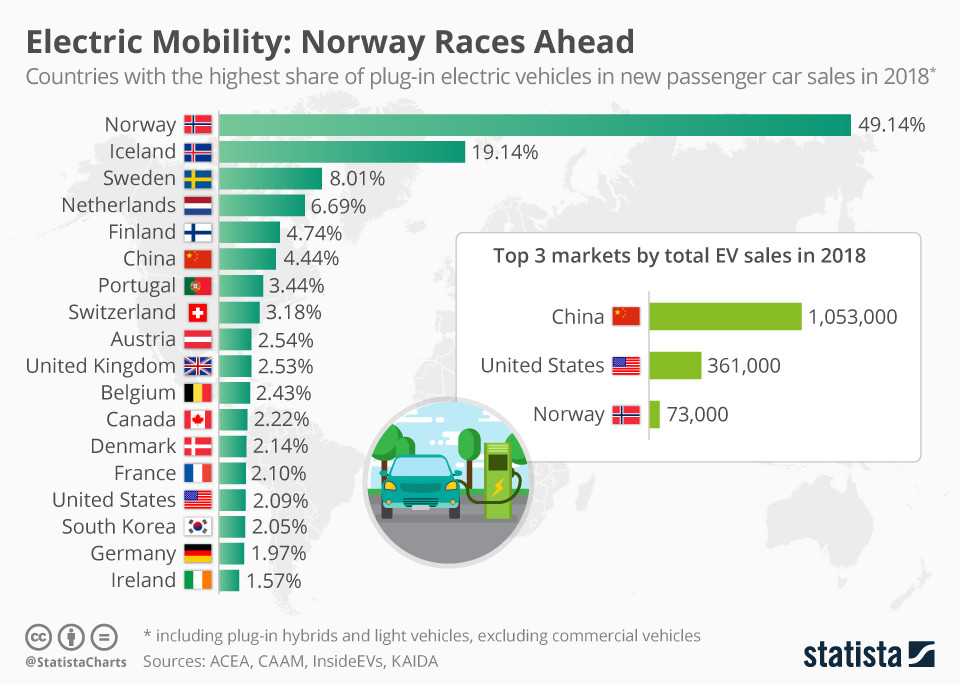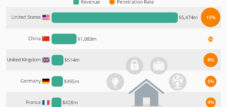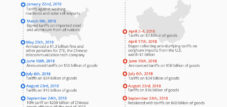Elektromobilität: Norwegen rast voraus – Electric Mobility: Norway Races Ahead
Sprachauswahl 📢
Veröffentlicht am: 14. März 2019 / Update vom: 1. Oktober 2021 – Verfasser: Konrad Wolfenstein
Auf dem diesjährigen Genfer Automobilsalon, der am Sonntag endet, standen Elektrofahrzeuge im Mittelpunkt. Angesichts strengerer Abgasnormen in Europa zeigten zahlreiche Hersteller ihre neueste Vision einer batteriebetriebenen Zukunft, wobei sowohl Concept Cars als auch marktreife Modelle stark vertreten waren.
Trotz eines robusten Wachstums und Rekordumsatzes beim Absatz von Elektrofahrzeugen in den meisten der größten Automobilmärkte dominieren Verbrennungsmotoren weiterhin den weltweiten Pkw-Absatz. Der Anteil der Plug-in-Elektrofahrzeuge an den Verkäufen/Zulassungen von Personenkraftwagen und leichten Nutzfahrzeugen insgesamt lag 2018 in allen bis auf vier Märkte unter fünf Prozent, wobei Norwegen mit 49 Prozent die bemerkenswerteste Ausnahme bildete. Da Island, Schweden und Finnland ebenfalls zu den Top-5-Ländern mit dem höchsten Anteil an EVs gehören, setzen die Nordländer die Elektromobilität schneller ein als jeder andere Teil der Welt. China, der nach Stückzahlen bei weitem größte Markt für Elektroautos, liegt mit einem Anteil von 4,44 Prozent an sechster Stelle hinter Finnland.
Während sich die politischen Maßnahmen Norwegens (z.B. Steuerbefreiungen, Mautbefreiungen und andere Anreize) bei der Förderung von Elektroautos als sehr effektiv erwiesen haben, lässt sich das norwegische Modell nicht ohne weiteres auf andere Länder übertragen. In erster Linie erhebt das Land kräftige Einfuhrabgaben und Zulassungssteuern, was Autos deutlich teurer macht als in den Vereinigten Staaten. Durch den Verzicht auf diese Zölle für Elektrofahrzeuge subventioniert Norwegen effektiv den Kauf von Elektrofahrzeugen in einem Umfang, den sich ein größeres Land wie die USA nicht leisten kann. Zweitens ist Norwegen ein sehr wohlhabendes Land (ironischerweise dank seiner Ölreserven) mit einem hohen Einkommensniveau. Nach Angaben des nationalen statistischen Instituts Norwegens lag das mittlere Haushaltseinkommen nach Steuern im Jahr 2017 bei fast 60.000 US-Dollar, was in etwa dem Niveau der Vereinigten Staaten entspricht, aber mehr als doppelt so hoch ist wie der EU-Durchschnitt.
Electric vehicles took center stage at this year’s Geneva Motor Show which ends on Sunday. Facing tougher emissions standards in Europe, countless manufacturers showed off their latest vision of a battery-powered future, with both concept cars and market-ready models featuring heavily.
Despite robust growth and record levels of electric vehicle sales in most of the largest automobile markets, combustion engines still dominate passenger car sales around the world. The share of plug-in electric vehicles in total passenger car and light vehicle sales/registrations was below five percent in all but four markets in 2018, with Norway the most notable exception at 49 percent. With Iceland, Sweden and Finland also featuring in the top 5 countries with the highest share of EVs, the Nordics are adopting electric mobility quicker than any other part of the world. China, which is by far the largest market for electric cars in terms of unit sales, ranks sixth behind Finland with a share of 4.44 percent.
While Norway’s policy measures (e.g. tax exemptions, toll exemptions, and other incentives) did prove highly effective in promoting electric cars, the Norwegian model cannot be easily transferred to other countries. First and foremost, the country imposes hefty vehicle import duties and car registration taxes, which makes cars significantly more expensive than say in the United States. By waiving these duties for electric vehicles, Norway is effectively subsidizing EV purchases at a level that a larger country such as the U.S. couldn’t afford. Secondly, Norway is a very wealthy country (ironically thanks to its oil reserves) with a high level of income. According to Norway’s national statistical institute, the country’s median household income after taxes was nearly $60,000 in 2017, which is roughly in line with the United States but more than twice as high as the EU average.
Passend dazu:
- Elektromobilität: Europa rast voran
- Die Elektromobilität kommt langsam, aber sie kommt
- Ladeinfrastruktur für die Elektromobilität in Deutschland




























